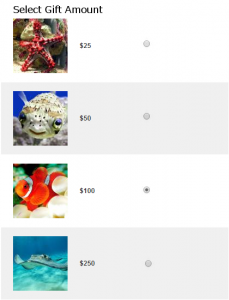
The 2014 Charitable Giving Report states that “online giving grew in 2014 by 8.9%.” That’s right on the heels of “13.5% year-over-year growth in 2013”. And it’s not just large, national organizations that are seeing a boost online. Nonprofits with “annual total fundraising less than $1 Million, grew…online donations more than large or medium-sized organizations.”
That is great news! And it should inspire organizations of all sizes to invest time and resources to be sure that they are poised to maximize online giving with solid strategies and optimized pages.
In his blog post, Nonprofits – Stop Leaving Money on the Table!, Scott Paley of Abstract Edge discusses some key elements: Anchoring, Decoys, Avoidance of Extremes, and Path of Least Resistance. He provides great insights and suggestions to help nonprofits maximize the average value of online gifts.
As I read his post, I found myself thinking, “Yes!….but….”.
As Scott notes, most donation pages are comprised of a series of giving levels and a field for a variable amount.
On a donation page like this there are a few levers that can be adjusted and tested to maximize conversion or average gift amount.
1. The number of giving levels presented
2. The value of each giving level
3. The default value
4. The order in which the values are presented (I added this one to Scott’s list)
Scott makes solid recommendations in his post regarding what to consider and test on a basic form like this and I encourage you to read his post. My “…but…” comes in to play because there are two other levers that should be in play here.
An image associated with each giving level
AND
A brief description of what impact a gift at each level can have
IMAGES
Many of the best practices now applied to donation pages came out of the ecommerce space, but when it comes to effective use of “packaging” to drive conversion, nonprofits are still lagging behind.
Scott Albro, in his blog post “How Images Drive Conversions”, notes that images “have the potential to dramatically increase conversion rates” in part because “images can be a subtle, but powerful cue to guide people’s behavior.” How might this apply to nonprofit appeals?
Consider the following donation page:
Let’s say my goal is to increase donations at the $100 level. So, I make this the default giving level and I associate a picture of well-loved “Nemo” with that amount. Of course I then need to test to see how my page performs, but the addition of images to represent each giving level not only makes for a prettier, more engaging donation page, it also gives me another lever I can use to drive conversion.
As Zach Bulygo points, “Images are powerful. They can tell a story, persuade, inspire, and much more.” For this very reason, I would love to see more organizations utilize images as an integral part of each donation level.
DESCRIPTIVE TEXT
Another universally accepted notion in the ecommerce space is that, “paying attention to product page copy can help improve conversions rates, as better copy can be more informative and persuasive.” But how does this apply to nonprofit donation pages?
Donors have told us that they give to organizations that tell them what their gifts accomplish. Let’s think about this in the context of the research of Harvard psychology professor Ellen Langer. She and her colleagues found that requesting a favor resulted in 60% compliance. Asking for the same favor and adding the word “because” followed by a reason (even a nonsensical one) resulted in over 90% compliance.
People want to know WHY they should take a requested action and if told, they are considerably more likely to take it. They also have a knee-jerk tendency to respond more favorably to a request when it is structured such that the request is accompanied by an explanation. On a donation page, the descriptive text is your BECAUSE. You are saying to a donor, “You should give me $100 because I can provide a week of after-care to a child” or “Please give us $50 BECAUSE we can feed a koala for a week.”
If organizations package their donation levels as “items” with gift amounts, images, and descriptive text there is so much more opportunity to communicate and persuade donors to give as much as possible. If your organization employs images or text in this way, please share comments!


